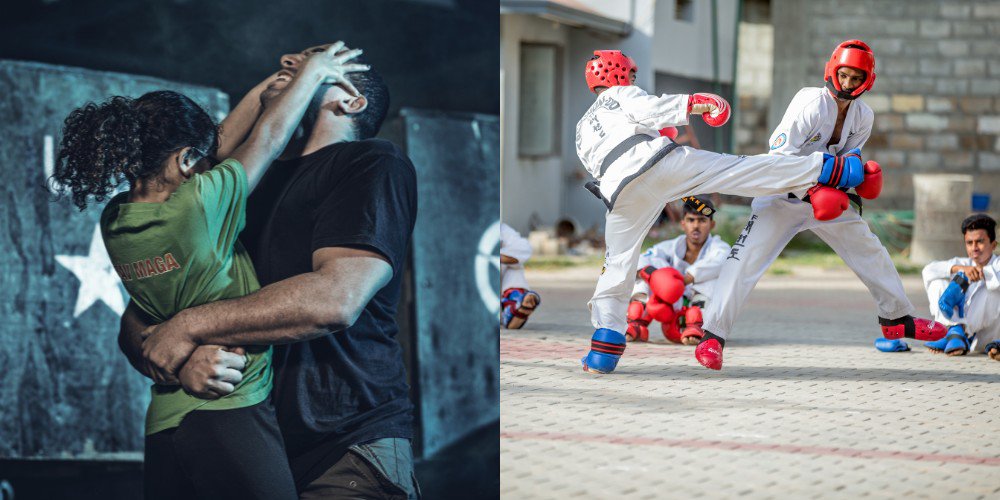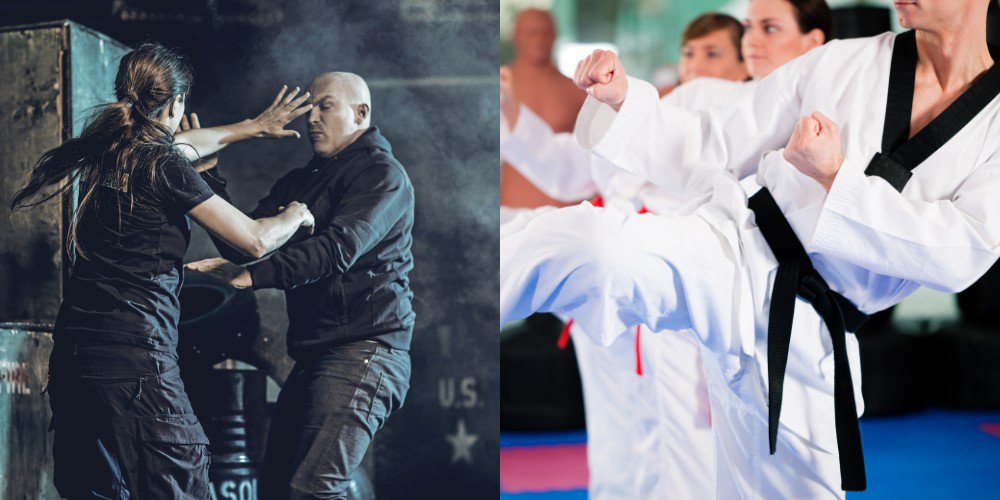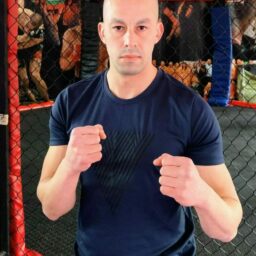Martial arts often carry deep philosophies and are ways to express yourself, but they contain the martial element at their core. Some systems are better at real fighting than others, and many people choose more effective styles that can be used for self-defense, while others prefer the thrill of competition and go for a sports-oriented style. This is also the case when comparing Krav Maga1 and Taekwondo.
Krav Maga is a self-defense system entirely oriented toward teaching people how to deal with real-life situations and aggressively and quickly dispatch attackers if a fight is unavoidable. On the other hand, Taekwondo is a traditional martial art with a main focus on sports competitions.
The concepts, mindset, techniques, and goals of Taekwondo and Krav Maga seem alien to each other, but they still belong to the martial arts family and can and should be compared in some key categories.
What Is Krav Maga
Krav Maga is solely a self-defense system. It is intended to incapacitate or even kill the opponent quickly and efficiently. It is not a sport in any way, there are no competitions, and no rules.
It combines various martial arts techniques from boxing, judo, wrestling, jiu-jitsu, and many others while also dealing with the use and defense against weapons.
It could be called the MMA of real-life combat because it aims to incorporate everything that works from other disciplines.
Krav Maga’s origins can be traced back to the streets of 1930s Bratislava, Slovakia, where Hungarian-Israeli Imi Lichtenfeld, who was an accomplished boxer, wrestler, and gymnast, used his extensive skills to fight antisemitic gangs before World War II.
After the formation of Israel, he moved to live there and started teaching martial arts to the military, which led to the creation of the system of Krav Maga.

How to Dominate Every Fight with Raw, Explosive Power No One Can Match
Discover the underground blueprint that has quietly turned MMA hopefuls into legends, using nothing but sheer, brute force and bulletproof conditioning techniques.
Initially, solely for military use, the system began finding its way to civilians and was gradually changed to reflect the situations ordinary people can encounter.
Today, Krav Maga has schools worldwide and is one of the most popular self-defense systems.
What Is Taekwondo
Taekwondo is the national martial art of Korea and an Olympic sport. It is a striking martial art with a strong emphasis on kicks. Taekwondo is distinguished by its sports rules, which produce fast-paced kicking battles determined by speed, accuracy, and agility.
The origins of modern Taekwondo can be traced back to the ancient martial arts “Subak” and “Taekkyon,” which were important in different eras of Korean history.
The modern sport was developed in the twentieth century through the combined efforts of other traditional martial arts masters, whose efforts were formalized in 1959 with the establishment of the Korea Taekwondo Association.
Taekwondo is a very popular martial art, and Its structure, well-developed dojo system, and competitive scene make it a favorite among children.
Today, there are two versions of Taekwondo, the most popular of which is the WTF, also known as Olympic Taekwondo.
Taekwondo’s inclusion as a demonstration sport in the 1988 Olympics and added as a full event in 2000 greatly expanded its global reach and popularity.
Key Differences Between Krav Maga and Taekwondo

Key Features and Differences
- Krav Maga is only a self-defense system with no sports element. There aren’t any competitions (with minor exceptions), and so there aren’t any rules the techniques and training must comply to
- Taekwondo is a sport, and the goal of training is mainly to teach you how to win under the sports ruleset.
- Krav Maga encompasses all hand-to-hand fighting aspects, including striking, grappling, and defense against weapons.
- Taekwondo is almost entirely centered around kicks, with limited punching and no grappling.
- The philosophy of Krav Maga is maximum efficiency in an actual situation by any means necessary. At the same time, Taekwondo is a traditional martial art emphasizing full character development and personal growth through martial arts.
Techniques
TKD is well known for its powerful kicks and fast-paced action. It focuses on agility, flexibility, and speed. Practitioners practice strong and precise kicks and limited punches and blocks.
A key characteristic of Taekwondo is the spinning and jumping kicks, which make it a visually stunning martial art.
In the Olympic taekwondo ruleset, which is by far the most popular worldwide, punching to the head is forbidden, and punches to the body are poorly scored, so the game’s entire focus is on kicks. ITF taekwondo features head punching, but kicks remain the primary weapon.
Krav Maga uses many techniques, from striking to grappling martial arts. All kinds of punches, hand strikes, elbows, kicks, knees, joint locks, and takedowns are utilized.
Krav Maga does emphasize natural and instinctive movements, so the execution of specific technical details is not as strongly advocated.
In addition to techniques found in other martial arts, Krav Maga also includes a lot of dirty moves like eye gouging, groin strikes, throat strikes, and generally, everything proved effective for the end goal.
Philosophy
The philosophies and mindsets of KM and TKD are entirely different and should be heavily considered if you are hesitating about which one to train in.
Krav Maga intends to be strictly a real-life fighting system and foregoes everything not directly serving this purpose. The fundamental principles of Krav are using efficiency and aggression to ensure survival. The techniques are not so important; the result is all that matters.
The mental elements include developing awareness and instinctive reflexes to use in stressful and violent situations. Also important is learning how to de-escalate situations and prevent fighting in the first place.
On the other hand, Taekwondo is a traditional martial art with all the elements this term entails. The Korean style aims to instill ethical discipline, etiquette, justice, respect, and self-confidence in its students. It is an art touching on all physical, mental, and spiritual elements.
Also present are the ritualistic elements of traditional martial arts, represented in the uniform, hierarchy including a belt ranking system, training session structure, and many other elements.
Training Methodology
Another key difference, and one of the most important, is training methodology.
Taekwondo is a well-developed style with two main organizations, training methods, and teaching structures. This means the training methodology is similar everywhere you go.
It includes warming up, stretching, many drills, and developing physical qualities and techniques, usually kicking pads. And the last crucial element of TKD training is frequent sparring.
There are many fake schools in the USA, but if a dojo is a part of the big organizations and is taking part in big competitions, it likely teaches Taekwondo correctly.
Krav Maga training, on the other hand, is a complicated topic. Krav has organizations, but many schools are not part of them, and everyone can teach whatever they like and have a Krav Maga sign over the front door.
The lack of competition and the fact that Krav is not characterized by techniques but only principles mean everyone can interpret them as they see fit, and there is no testing field to check their legitimacy.
This leads to dramatically different experiences in different academies. The biggest shortcoming of Krav Maga at large is the lack of pressure testing and sparring.
Most schools do shadowboxing, use pads and heavy bags, and drill techniques with training partners who don’t offer any resistance.
While the techniques are usually real and come from legitimate martial arts, this training methodology does not lead to being able to use the techniques on an aggressive person.
Some places are even worse and do aikido-style training, or whatever the instructor’s base style and expertise are, disguised as self-defense.
With that said, good Krav Maga schools are teaching in a practical way. Some places have instructors with a solid fighting background who teach fundamental skills and utilize sparring and realistic scenarios.
The best Krav Maga schools even use situational sparring and simulate different possible scenarios, like multiple attackers, being in tight spaces, multiple attackers, and many others.
A Krav Maga school’s training methodology is critical in determining if a school is legitimate or teaches what is commonly referred to today as “bullshido.”
Krav Maga vs Taekwondo For MMA

Taekwondo is better in terms of skills crossover to mixed martial arts.
Krav Maga is not a sport, and the way of practicing is not conducive to effectiveness in MMA. The principles of going all out in aggressive and fast action in a fight rarely work well against a trained opponent, and many techniques taught in Krav Maga are banned in MMA.
But then again, Krav Maga’s training often looks like MMA training without the sparring and the physical conditioning.
Krav takes techniques from all combat sports like MMA, so some skills are transferable if training includes live sparring and grappling.
Taekwondo can and has been used with great effect in MMA. Speed, agility, distance management, and the power of kicks work wonderfully in mixed martial arts, but the style requires heavy modification when you include full striking and grappling.
Some elements of Taekwondo are great for MMA, but as a separate fighting style, TKD is not effective in a cage fight.
Krav Maga vs Taekwondo For Self-Defense
Self-defense is the primary goal of Krav Maga, so it should be effective and much better than Taekwondo, right? Not necessarily.
It all comes down to the training methodology. When you watch videos online, a lot of Krav Maga is complete and utter nonsense.
Training with partners who fill the role of a dummy and go limp the second you touch them is nothing like trying to control someone who is trying to smash you to pieces.
Sadly, most schools teach this way, and regardless of the endless debate on the topic, there is no way to learn how to fight without real pressure testing and some form of sparring.
Not only is training against organic dummies not effective, but it can be harmful because you can develop a false sense of security and make things worse.
Just look at a few demonstrations of knife and gun disarming if you want to learn how to get instantly killed.
I highly recommend people skeptical about my opinion to watch this episode and, in fact, the whole series titled The Ultimate Self-Defense Championship:
On the other hand, there are solid Krav Maga schools, and I’ve seen some excellent practices. The criticism of combat sports in real life is well-founded, and many of the habits and tactics used in competition do not work.
This is why good Krav schools utilize proven working techniques from combat sports, but pressure tests them in real-life scenarios and outside of the confines of any given sports ruleset.
But what about Taekwondo?
Taekwondo is not particularly good for self-defense, either. While TKD kicks are extremely powerful, quick, and accurate, and practitioners are athletic, kicking in a street fight is dangerous and highly situational.
Your entire kicking game may be ruined by tight spaces, slippery surfaces, fashionable and completely unpractical clothes, and many other factors.
The lack of effective punching and any form of grappling makes TKD too limited and situational for self-defense. There have been some real-life occurrences with flashy street knockouts worthy of an action movie.
However, relying on acrobatic kicks is too risky for something already posing a lethal threat.
Krav Maga vs Taekwondo Which Is Better?
There is no definitive answer to this question because, for some, TKD is the better choice, while Krav Maga is preferable for others. Let’s summarize what they both bring to the table to help you make a pick.
Taekwondo Pros
- It has a well-developed competitive scene, and you can become a competitor. You can even participate in the Olympic games as a TKD athlete.
- TKD has a deep philosophy and principles, making it a system for complete character development and not just fighting
- It is fun, attractive to watch, and highly impressive
- Develops incredible physical attributes
- It has strong cultural and traditional elements
Taekwondo Cons
- It depends on flexibility and agility, and if you haven’t developed them as a kid, it’s unlikely to do it as an adult. TKD is excellent for kids but not so much for beginner adults
- Not realistic. Taekwondo is known for poor results against other styles and in self-defense because of the limiting ruleset. Most other combat sports are more practical and realistic.
Krav Maga Pros
- The principles allow you to learn basic techniques and tactics quickly
- The lack of traditional elements makes training straight to the point
- It has no requirements for physical attributes
- Teaches all aspects of fighting
- If taught correctly, it is highly effective for self-defense
Krav Maga Cons
- Finding a good school is a challenging task. Most teach unrealistic techniques in unrealistic ways, making them useless for self-defense. And since Krav Maga is only about self-defense, if this element is not good, there is no point in training in Krav Maga.
- No competitions. For many, this is not a con, but for some, it is, and it takes away a significant factor in what makes combat sports effective.
Hopefully, this extensive look into both styles gives you a much better perspective and what value they may provide, or you have simply expanded on your martial arts knowledge.

